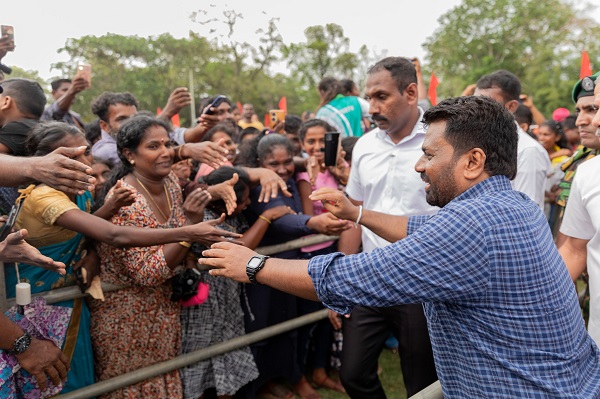-By Chandrapradeep

(Lanka-e-News -01.May.2025, 11.00 PM) "The march of history does not move in a straight line, but spirals upward through the dialectic of action and reaction—each contradiction resolved through synthesis, giving rise to more refined systems of understanding." -G.W.F. Hegel, before he was cool.
July 9, 2022. The day Sri Lankans tore through the colonial columns of the President’s House, climbed the plush sofas, and photobombed the presidency into exile. On July 10, this humble scribbler placed a call to Brother Anura Kumara Dissanayake—the austere intellectual face of Sri Lanka’s Marxist-turned-electable Left. Why? To grasp, if at all possible, what the Left’s dear leader thought of this spontaneous historic upheaval. His answer was classic Anura: no drama, no slogans, no hashtags—just data and a cup of tea.
"How many comrades did the JVP bring to Colombo yesterday?" I asked.
"Ah, not many of ours were there," replied Brother Anura. "It was mainly Vasantha’s crowd and Mahinda Jayasinghe’s folks. Maybe 2,000 from our side at most."
When I told him the police estimated a crowd of two million, his eyebrows didn’t so much as flinch.
"Yes, we expected maybe 15,000 to 20,000 tops. We didn’t think it would be this massive."
And with that, Anura began to think differently. Act differently. Organise differently. While others gasped at the tsunami of rage that drowned the Rajapaksas, Anura sharpened his pencils and got to work.
Fast-forward one and a half years: thousands of women—never previously mobilised under any political banner—marched under a slogan that could make even Westminster blush: “We women, united as one!” Eyes across the world opened wide, not just to Sri Lanka’s protest culture but to its sudden capacity for structured, strategic transformation. A headless uprising had found its head, and the head was Anura.
The movement got a name: the National People’s Power (NPP). The world simply called it the Red Tide.
On September 21, 2024, the unthinkable happened. Anura’s Malimawa (meaning “power wheel,” and now looking suspiciously like a juggernaut) rolled over the opposition, scoring a democratic tsunami. By November 14, he was rallying four times a day, North to South, East to West, filling Parliament with 259 seats. A parliamentary monsoon like none before.
And now? With barely a tea break, he’s charging toward the provincial elections. Sleep, it seems, is for the ideologically bankrupt.
Let’s rewind back to Hegel—the 19th-century German philosopher best known for making people pretend they understood him. He insisted history wasn’t linear but spiral-shaped, progressing by bouncing between contradictions, always upwards. That’s essentially Anura’s journey too.
Here’s the blunt truth: Today’s NPP is not Rohana Wijeweera’s JVP. Nor is it Somawansa Amarasinghe’s. This is Anura’s NPP. And that matters. Because to accuse today’s Malimawa of yesterday’s sins is like blaming Keir Starmer for Tony Benn’s moustache.
If 2015 was Act I of the spiral—the defeat of the Rajapaksa clan through the Yahapalanaya coalition—then the disaster of the Sirisena-Ranil bromance marked the fall. The Rajapaksas sniffed the vacuum and launched their comical 52-day coup (a political equivalent of sneaking back into a party you were thrown out of). Then came Easter bombs, bankruptcies, and finally, the people’s boot.
But when Gota fled and Basil slipped into hiding like a Bond villain trapped on an island, it wasn’t Sajith Premadasa or Champika Ranawaka who offered a political compass. It was Anura, long before the bandwagon even had wheels.
While Anura rides Hegel’s spiral upward, the opposition seems stuck in a snake pit of its own making. Confused, leaderless, and incapable of drawing a crowd big enough to start a whisper, they’ve found a catchy new slogan to shout from empty stages: “This is a Tom Pacha Government!” ("Pacha" in Sinhala, loosely translated, means a lie wrapped in nonsense).
It’s an old tune, this “pacha” business. When Chandrika Kumaratunga ran for president in 1994, she too was accused of being a trickster wrapped in socialist velvet. Back then, the JVP didn’t field a candidate. Instead, they made a gentleman’s (and comrade’s) agreement: Chandrika would abolish the executive presidency within a year.
Spoiler alert: She didn’t. Instead, she luxuriated in executive power like a cat in a sunbeam, accompanied by Sanath (her keep, not the cricketer).
By 1995, the JVP was on the warpath with a memorable campaign: “Send the Pacha Mall Home!” (mall = sack; you can guess the contents). They were the first to introduce the idea that a government could be factually, ontologically, spiritually "pacha".
And so, in true Hegelian fashion, history did not repeat but rhyme. The spiral turned. From 2015’s reformist dreams to 2019’s nightmares. From the faceless Aragalaya to the face of Anura. From failed coalitions to a disciplined people’s movement. From cynical voters to hopeful ones.
The Opposition, meanwhile, dithers with vague accusations, as if calling someone “Tom Pacha” is enough to win elections. It isn’t. Not in this version of the dialectic. Because if Hegel taught us anything, it’s that progress comes not from whining about the past, but by synthesising its lessons into something newer, sharper, and un-pachably real.
-By Chandrapradeep
---------------------------
by (2025-05-01 17:39:42)
Leave a Reply